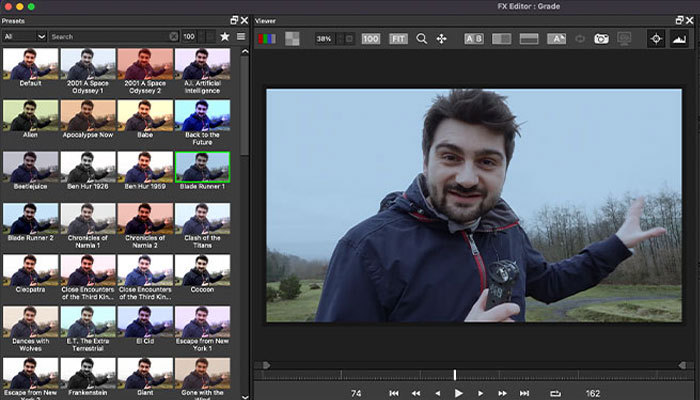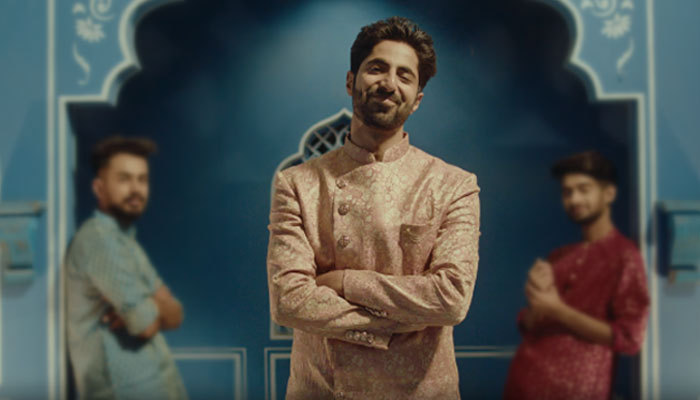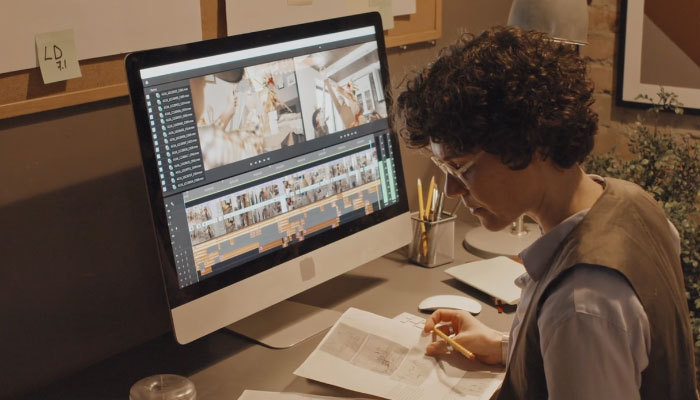Today, on Art of the Cut, we’re speaking with Jonathan Redmond and Matt Villa and their editing of the Baz Luhrmann film Elvis.
Jonathan has edited the film The Great Gatsby and the TV series including The Get Down, Wonders of Australia’s National Parks, Romeo & Juliet: A Monkey’s Tale, and Pelicans of the Ghost Lakes. He was also First Assistant Editor on Moulin Rouge.
Matt Villa has edited features including The Great Gatsby, Peter Rabbit 2, Winchester, and Predestination. He was also an additional editor on the Lego Batman Movie, The Lego Movie 2, Happy Feet 2, and Australia. Short on time? Read our 5-minute best of recap.
Art of the Cut with the Editors of Baz Luhrmanns Elvis
I really love this film. Congratulations to both of you on some superb work. One of the things that I wanted to bring up is the idea of building a scene to a release point. One of the ones that I was thinking of was the 'Play House With Me' song at the beginning. There's a tension to it, which I thought was built beautifully in editorial. Then followed with a release.
VILLA: All of the performances were shot conventionally, so Austin would just get up and do his thing. We also had a fantastic audience that had some wonderful girls that were handpicked for their ability to scream and shout. The performances throughout the film were there to serve a different purpose. The hay ride scene was to do just that, suggesting that this was Elvis's first blast onto the world stage. The idea was to capture that ecstasy that people had never seen before in his performance. We then move on to the Russwood performance and that was all about defiance. Then the comeback special was something under itself. Later on, Vegas was all about just the extraordinary music and the different take on the music that he had. So each of those set pieces had a different purpose.
As far as the build was concerned, it was a great testament to how Austin was able to perform as a younger, nervous self. It was very important for Baz Luhrmann that we captured that the movements in his leg shakes and so on were nerves, not the intent. From that point forward, John and I worked really closely. One of the big virtues of this film was we were working hand in hand always with the music department, who were right next door from where John and I were cutting. So we'd cut that scene, particularly the hay ride conventionally. Then it was just a case of exploring the material and nailing down the narrative of the fact that there was this kind of energy working throughout the room. The music guys next door came in with the screaming guitars that you hear in the film as a way just to capture the music. It was an evolution that started from a very conventionally shot scene, and then we just built the narrative into it from there.
REDMOND: It was tightly scripted — working with the writers and Baz and the music guys. We developed that sequence very thoroughly to have a build that basically takes you from the hay ride alley through his background. Then it lands you with a nervous Elvis on stage, which then pauses and then builds again. So it was one of the few sequences in which we did really dig deep and explore.
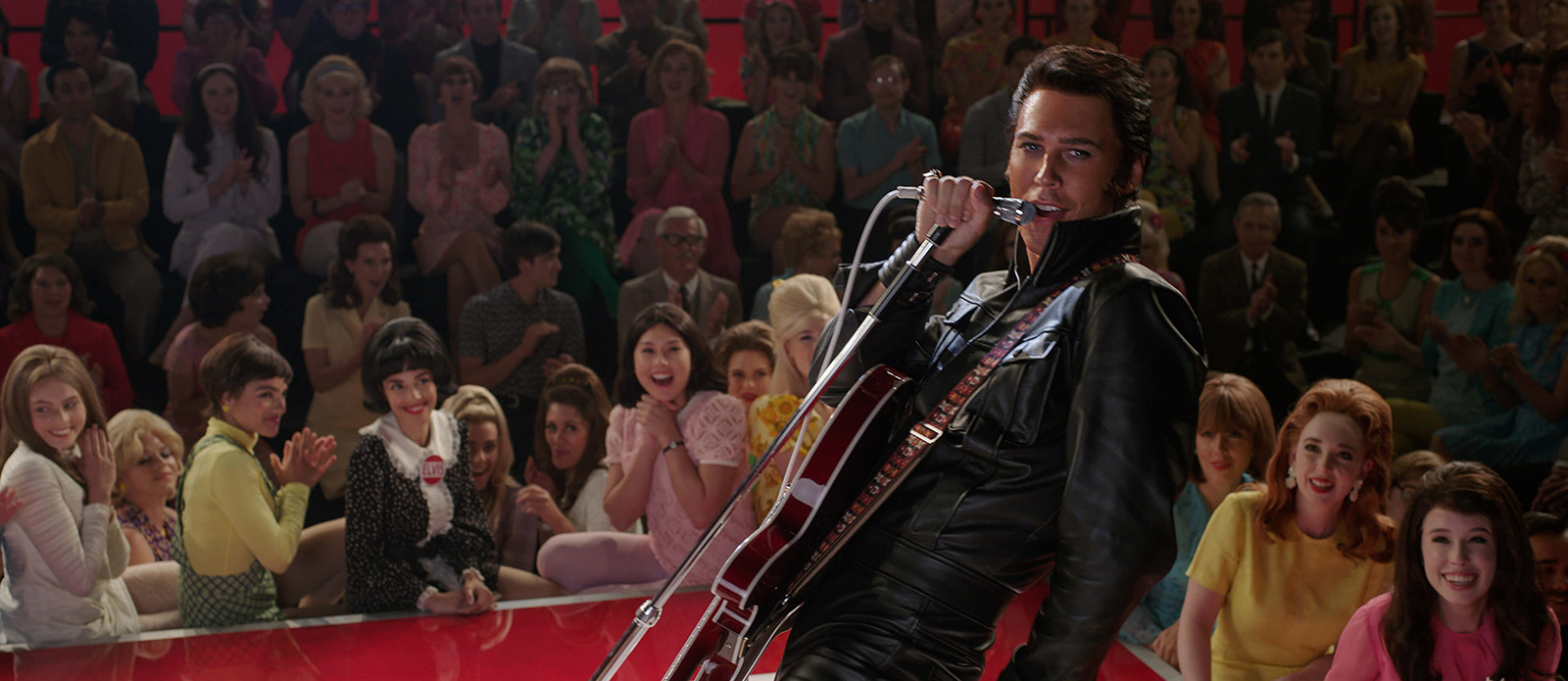
How much were you guys involved in pre-production?
REDMOND: Quite a lot. I first started this project about five years ago, even before there was the script. Baz had an idea of making an Elvis film even before he even pitched it to the studios. He just wanted to scratch the itch. We did a lot of research a long time ago in collaboration with Katherine Martin, his costume production designer, and the music guys, Elliot and Jameson. We just started cutting materials years before we shot anything. With Elvis as a subject matter, there are a lot of kinds of visual materials to explore and play with. So we ended up exploring a bunch of different things and smashing different types of music against different kinds of visuals and explored the subject in great detail, which then was used to present to the studio to get them excited. Then we used those same materials to get the cast excited and involved in the project. So Baz always does a lot of very thorough research in pre-production. He digs deep.
For those who have not seen the film, there's some modern music. Were you exploring if you could put that kind of music in with Elvis visuals
REDMOND: To a certain extent. There was lots of discussion about us making a movie about Elvis Presley and the music is so well known. 'Hey Baby Let's Play House' is a perfect example of music that was shocking to a young audience and to an older audience back in the fifties. How do you decode that kind of sense of shock and awe to a younger audience today when the music vernacular is so different? That's something I think Baz does very well. We were definitely exploring how faithful we need to be to Elvis' music and how do we push it to decode what it meant back then to a young audience and how radical it was.
Matt, what else were you exploring as editors? Were you being relied on for story sense? Was he running script or narrative ideas past you?
VILLA: I was on a film that led up to this, so I wasn't around as much as John was in the pre-production stage. We've worked with Baz for a long time. We've worked with him for over 20 years in various capacities so we are very attuned to his style and his way of working. Because of that and because of the really thorough work that Baz and the team and John had done before the film started, it was quite easy to arrive just in time for the shoot and be able to slot into the fundamental work that had been done. As John said, there are hours and hours and hours of Elvis footage to watch to get up to speed with sort of the background material.
John, since you were there for more of the beginning of the pre-production stuff, was there a discussion with you about narrative?
REDMOND: There were many different drafts of the script that were developed over a period of a couple of years, and the whole COVID pandemic kind of changed things in that regard as well. On a pretty regular Baz would get all his team together and we do script reads and a long extensive hour's worth of notes and feedback and collaboration. The first thing we presented to the studio wasn't a script, and it wasn't a treatment. Baz nicknamed it ‘the script-ment’. From there we started building out sequences. The music guys who played such important partners in this movie were involved in the very early stage as well. So it was a great kind of collaboration between music, editorial, and costume design. We did a lot of work in the early stages when COVID hit and we did get shut down but that also allowed us extra time. He had already done some kind of rehearsals with the actors in the cast, and it gave him some fresh ideas to be able to go back in and rethink the script to a certain extent, particularly with the time constraints we were then under to shoot the movie in the new post-COVID world.
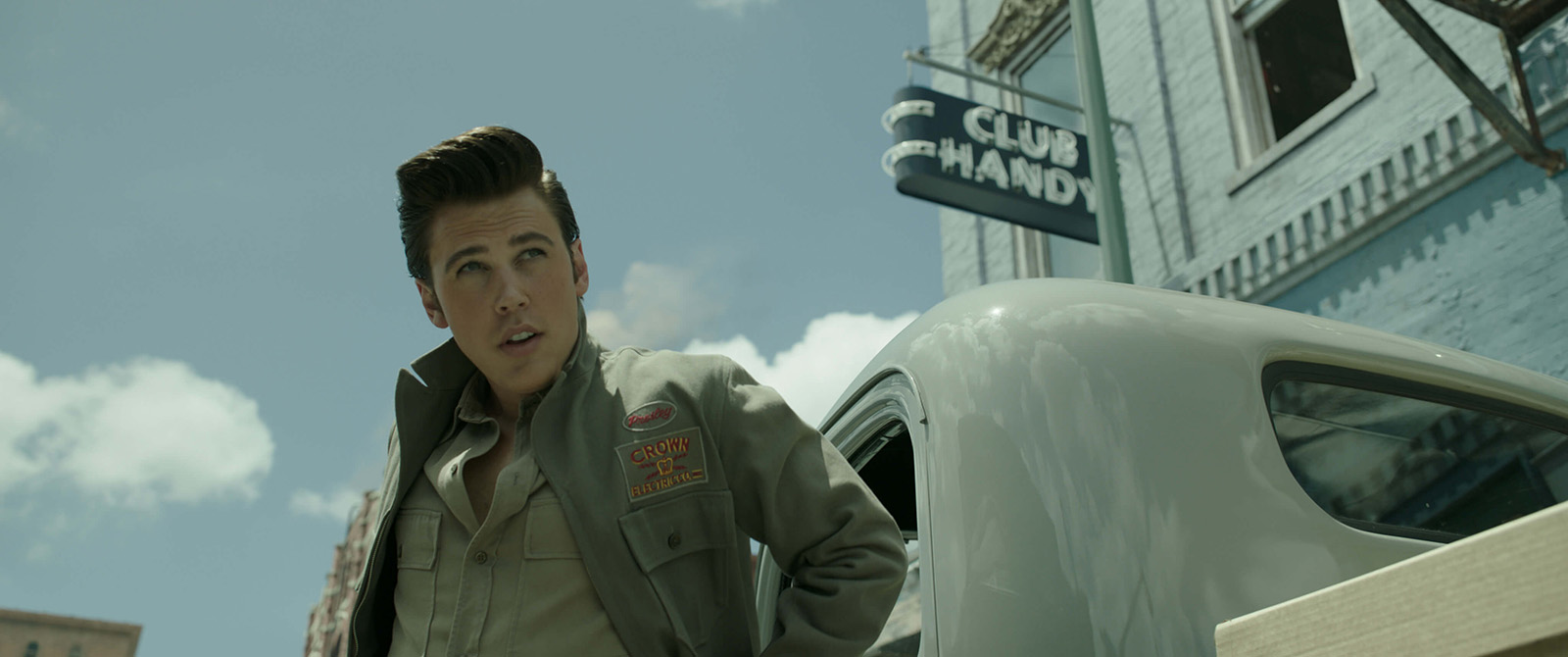
Matt, you mentioned the intent of the hay ride scene. That scene had not only a narrative reason but also to show Colonel Parker seeing the fervor. He's looking for a crazy kind of carnival ride and he finds it. So you're trying to show that Elvis is what he was looking for.
VILLA: Yeah, that's right. He was just looking for the next thing that elicited this response from an audience, and it was just a carnival-like thing that he was after. That was the first time that Colonel had seen this thing on stage just unleash onto an unsuspecting audience and the result that it had. That was a key part of the narrative. There's always that device in all the performances. Baz loves to cram a lot of information into a short amount of screen time.
The Comeback special, we were jumping up to the control room to see what was going on up there and Colonel's exchange with the executives, and in the showroom, he was looking at how well this Vegas opening was going, especially in the light of the new deal that he'd just done. So there was always that the whole narrative of this movie is all about Elvis and the Colonel and their impact on each other. It was always really important in whatever scene we were doing to check in on where the Colonel was at with his journey and with this new carnival act that he'd found.
You can pick scenes that you remember this happening with, but I want to stick with that idea of intent because when I was watching that hay ride scene, many of the cutaways were valuable. Colonel Parker isn't seeing that Elvis is some great musician…he's seeing what Elvis does to the audience.
You could have cut that entire performance where all you'd ever see is Elvis. Instead, you're trying to show that the audience's reaction is what Parker was looking for. Can you think of any other scenes that are like that, where you were aiming for an intent more than just a simple narrative?
VILLA: You are absolutely right. That scene could have been done by just showing the Colonel and the audience. There was also the effect that the audience's reaction was having on the mum because that was what she was seeing that night and what was happening to that crowd, to her, was dangerous for her son. It starts off checking on the Colonel and Elvis is giving his little speech about doing the right thing. There are very deliberate cuts to and a very deliberate link between Colonel and Elvis because to Colonel, there's this false sense of security that his boy was about to do the right thing.
The defiance sets in, and he starts his number. He starts the wiggle. He starts the leg shake. It was important for us to cut back to the Colonel to see his reaction that this was not going to plan at all. It's all about Elvis and Colonel and their point of view on each other.
Does Baz talk to you guys about intent, or is that something you infer from the script?
REDMOND: It's a combination of the script and the many conversations we have throughout the course of pre-production and production. There are always multiple things going on. The initial assembly was about four and a half hours long, and obviously, we need to take a lot of time out but there was so much good material that we're all quite precious about. We didn't want to cut stuff out, but through the nature of compressing the material, we ended up with a lot of kinds of music and dramatic narrative weaves, which have a similar effect of increasing the intent of any given moment to have kind of multiple levels of narrative.
VILLA: There were a couple of sequences that were always planned for those sorts of weaves. The Ferris wheel was always intended to weave a couple of different scenes together, when he is talking on the Ferris wheel, and we flash to the signing of the contract, flash to breaking up with his girlfriend, and so on. A lot of the others just come from often necessity to tell a lot of story in a short amount of time. Another one was the cutting between Elvis arriving on Beale Street and him arriving outside his home when he pulls up in the truck outside the Lauderdale Court's housing project. They were two very separate scenes that existed in two very different parts of the film but once again, as time became our enemy, Baz had an idea that juxtaposing those two scenes and intercutting them together shows that these are the two worlds that Elvis existed in, but belonged to neither. It never showed it quite as significantly separately as when they were meshed together.
Yeah, that evolution is really interesting.
VILLA: The four-and-a-half-hour assembly is the result of just a nasty slog to put something on the screen, and it's something that would never see the light of day outside of Baz. He saw it, and invited many of the Heads of Departments in to watch. Then of course, comes the heartbreaking process of throwing babies out but we started in a good place. It was called the “kitchen sink cut.” It was everything, including the kitchen sink.
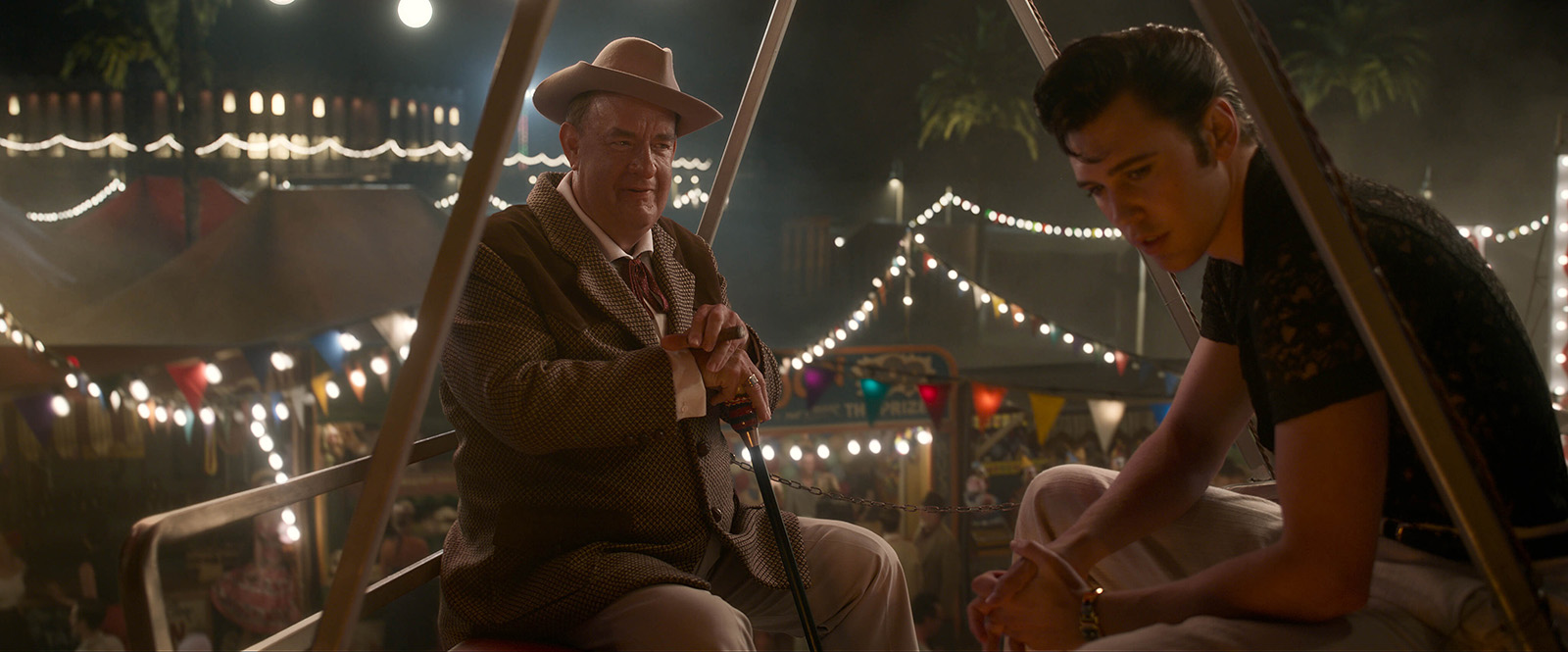
I'm really intrigued about some of the creative solutions that you had to come up with to be able to cut down the show. You mentioned the Ferris wheel ride. I remember that from the film and the intercut that took place.
REDMOND: So the camera moves that would flash away from the Ferris wheel were very much intended. That one was intended to do what it did.
Were there other ones that were not intended? Were there other places where you really had to come up with clever solutions to get that time?
VILLA: There was quite a number. At the end of Russwood, his being drafted into the army was another example. It was a much longer scene than it is now. At one point, it wasn't there at all. We just went straight from the end of the Russwood performance to him getting his haircut for the army. You don't want to take the lazy way out with voiceover, but thankfully, we did very much set up the voiceover device to help us through some moments. There's the conversation going on about the lack of security with Colonel Tom Parker and Jerry Shilling back in Colonel's office cutting back with him being attacked on stage. That was another device. The whole of Elvis's decline from the height of Vegas into his decline into his drug-addled state was another. There exists a much more dramatized version of that with that groupie that is in his bed, him going a bit mad and shooting the TV, and the whole breakup with Priscilla was much more elongated in the original cut.
John, can you think of other instances where you guys had to come up with some kind of editorial solution other than just cutting out entire scenes?
REDMOND: I think all the way through the film, there were hardly any musical numbers where we weren't interjecting drama into them and cutting away. I think that the end of the first Vegas year through 'Burning Love', the split-screen montage through his decline, was a huge kind of construct. I know for a fact we've got dozens of different versions which tell different narratives and different lengths. Baz is always obsessed with keeping the audience on the hook and keeping their attention firmly.
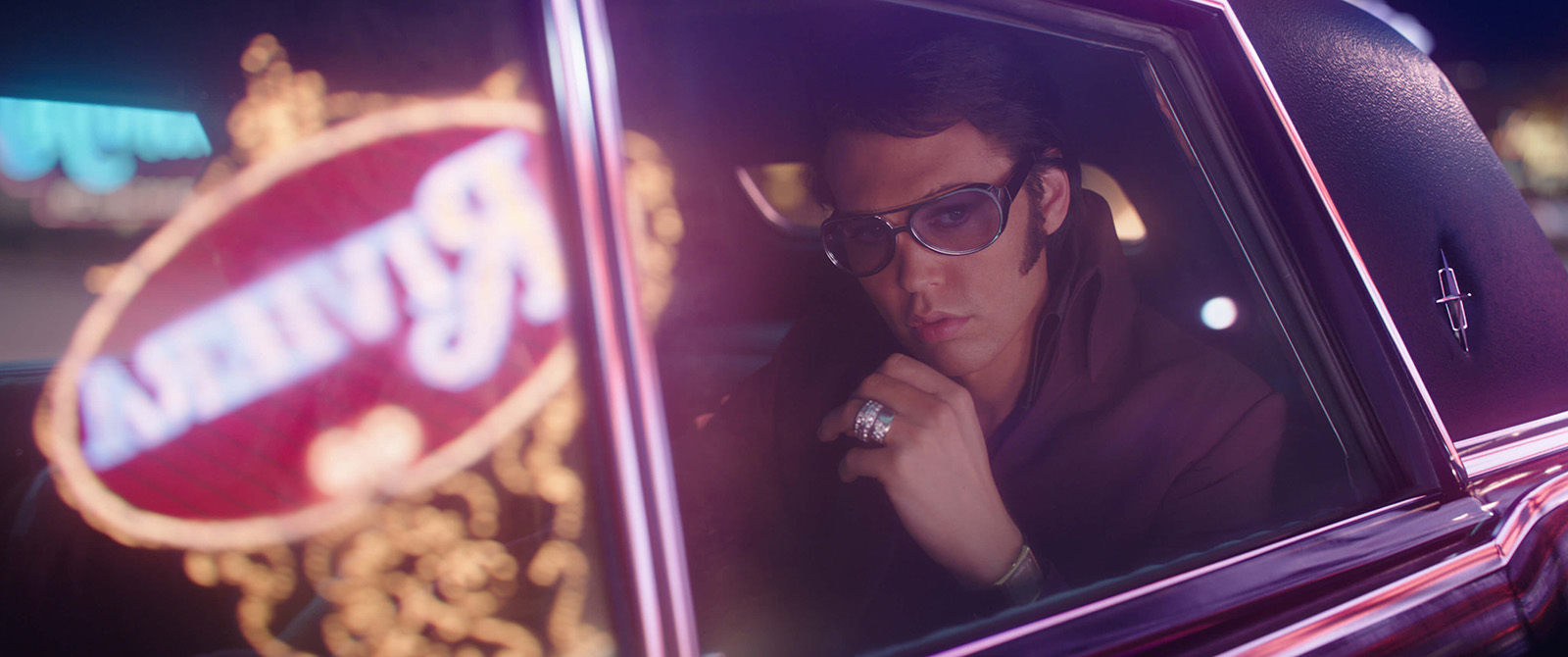
I am interested in the fact that you guys have both worked with him for so long and know that style so well. Can you talk to me about the benefits? You know some of the solutions that he'll provide or that you might do something crazy in editorial, but you know that he'll love it anyway.
REDMOND: It's fantastic. It's not just us working with Baz for a long time, it's Baz's team. We're almost like an extended family. It's a gift. It makes the process of working long hours much more interesting and fun. It's like a big traveling circus. The great thing with Baz is he creates a space where you can do something crazy, and even if it's wrong, that's okay. He creates an environment where people can go out on a limb and do something crazy, and that's okay. It's a lovely creative environment to work in where there is no wrong as long as you're trying something.
VILLA: Baz is an amazing collaborator. He's got the ability beyond anyone else I've ever seen that he can go into a room full of people and have a thousand ideas thrown at him (and, of course, he's got a million ideas in his head) and just take little bits and pieces of all of them and guide his way through. It's quite remarkable. He'll just cherry-pick all these little bits of pieces of thoughts and ideas and mold them into his singular vision. It's quite a privilege to be on such a team. We had an amazing setup where everyone was under one roof. We were all up in Queensland, Australia, on the Gold Coast, which is where the film was shot. So we could also come together and share where John and I were at with the edit, and music would provide stuff to us to cut to. We provided edits back to music. VFX was constantly coming in and out. We had this beautiful big purpose-built screening room where we could all gather. We were all there together and really evolved. It was very organic.
John, how did you guys collaborate? Were you sharing back into each other's scenes, or did you stay in your own scenes? How did that work when you went into reels?
REDMOND: There was a lot of back and forth. There are probably very few scenes where both of us didn't have our fingerprints on them. Baz likes to throw scenes and sequences around, particularly the scenes that need to be compressed and weaved that we were talking about earlier on. It was impossible to avoid in most situations on this. I have so much admiration for that, and hopefully, it's reciprocated. We've known each other for so long. He's just a joy to work with.
VILLA: I think John and I have got something kind of special going on. A very unspoken kind of rapport.
From a technical standpoint, do you both work similarly in a bin? Do you have your assistance prep a bin for you the same way?
REDMOND: We had two amazing first assistants and some fantastic second assistants. They could just create the daily bins in such a way that worked for both of us. We were able to share things incredibly easily. There was no kind of technical difficulties in having multiple editors.
VILLA: The assistants were great in setting it up so that one bin could be swapped over quite easily. I think we work pretty much the same, but if there were any tiny details, the assistants were very agile at providing what we needed.
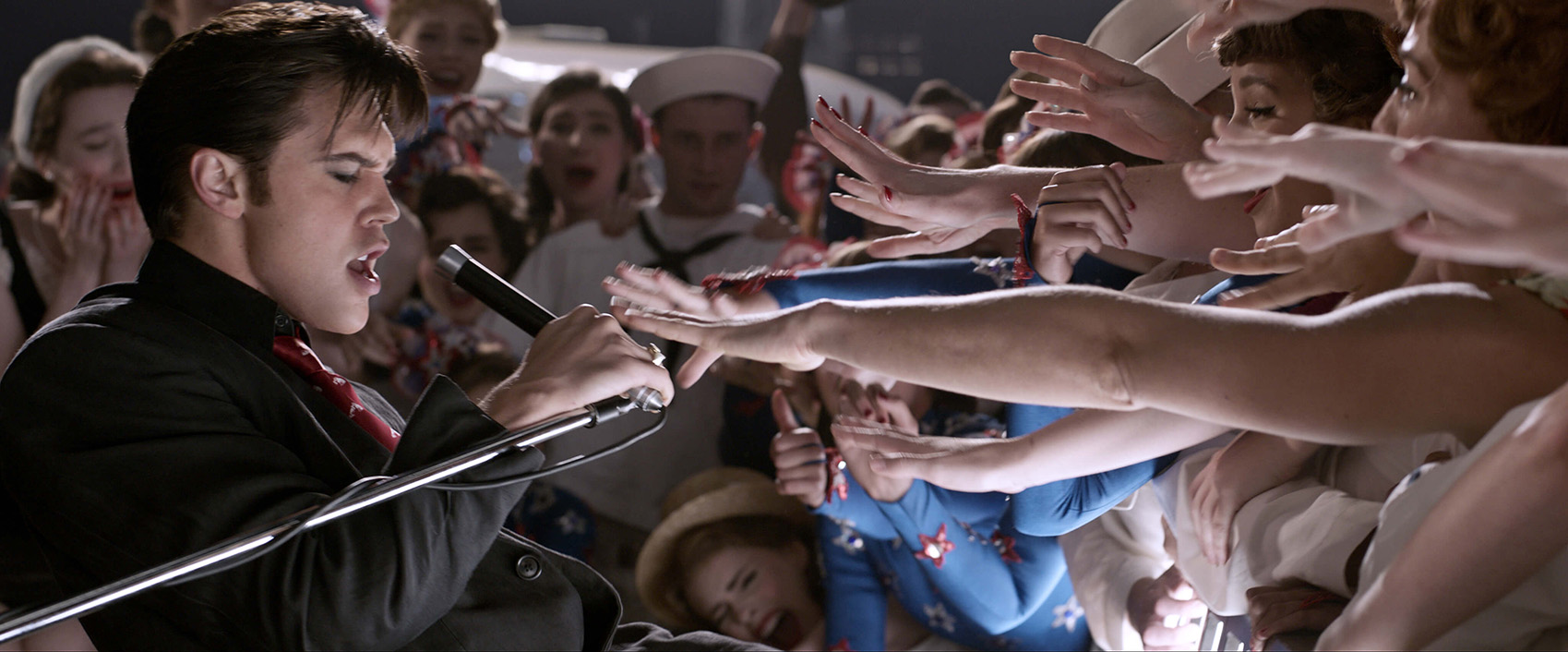
Can we give a shout-out to at least the first assistants?
VILLA: Dave Quinn and Walter Ratcliffe were just amazing. I'd worked with Dave one time previously on a film, but Walter came along. We interviewed him and took an immediate shine to him. Science took place between those two that was far beyond my understanding. Big shout out to second assistants, Jana Plum, Cory Augustyn, and Regan Hughes. A lot was resting on their shoulders as well from a technical standpoint. The stock footage in this film was a behemoth to wrangle, so that fell onto Dave Quinn's shoulders. The split screens fell onto Walter. So everyone would have these different little tasks.
We also must shout out Anika Damon, who came on a little later in the piece. The film has lots of different periods of montage in it. It was very important for Baz to have the style of a montage in the style of the time period that it was set in. For example, when Elvis set off on that first tour that ended up at the Daytona Fairground that was very much a 50's style with superimpositions and overlays and things like that. We just didn't have the time to craft the montages together, so we brought on a fantastic girl called Anika Damon, who was a Queensland local. She wrangled all that stuff together and did all the technical things required to make it work. We had a fantastic team. The VFX editors were great as well. We were very lucky.
You mentioned, Matt, that you rarely edit in Frame view. Most narrative editors that I talk to use Frame view. So how do you get the assistant to prep your scene? When you're looking at a blank timeline on a typical scene, what do you do?
VILLA: I do need to have a line-by-line string out of every line from every take from every angle so that I can compare what the different performances are.
Do you cut from that? Do you drop the line-by-line into your source monitor, or are you match framing back out of it? How are you using that?
VILLA: I'll always match frame out. I use it mainly as a reference, and I'll initially probably cut in from that. I'll always be just match-framing back to get other takes or other parts of the same take.
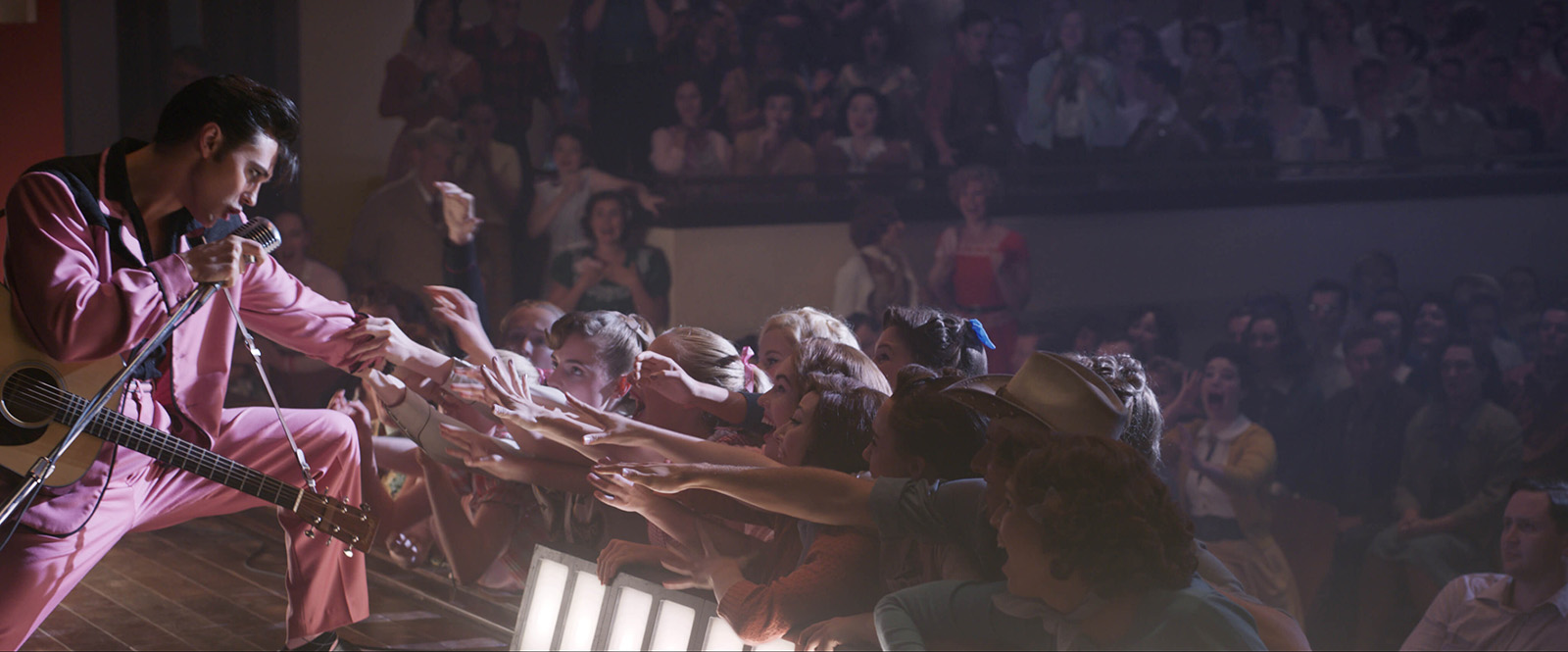
You're not the first one that I talked to that edits that way. I've been on Avid for 30 years now. I definitely started out as Text View only and only switched to Frame recently, but what about you, John? How do you approach a scene?
REDMOND: My initial background in non-linear editing was Lightworks, which I was a huge fan of back in the day. That was a very visual editing tool with thumbnails. Its ability to run a multi-screen cut was second to none.
Thelma would agree with you.
REDMOND: Similar to Matt, I'm a huge fan of a line-by-line string out to be able to review materials on the scene and just kind bits and pieces that interest me and take it from there.
VILLA: One of the big things that Dave and Walter, the first assistants, did for us was do these massive supergroups of all the performances. Basically, this multi-view mode but by factors of several. For all the takes of the performances, they stacked everything all together so that John and I could flip through. That was both terrifying but very handy.
REDMOND: It did almost break Avid at one point.
You're talking about using multicam groupings, right?
REDMOND: That's right. We're shooting some of the big set pieces, a minimum of four cameras, sometimes five, and multiple takes. So one of those supergroups could have 30-40 different shots. On top of that, Baz is a huge fan of rolling resets, so any one take might have five or six sub-takes within it. Keeping track of that was also challenging, not just for us but the assistants as well. Even though we're shooting digital, there are still limits as to how long the camera can roll, but everyone did a great job. It was a lot of material. It was well over 600 hours' worth of stuff.
My gosh.
REDMOND: It took a lot of work for these systems to wrangle that.
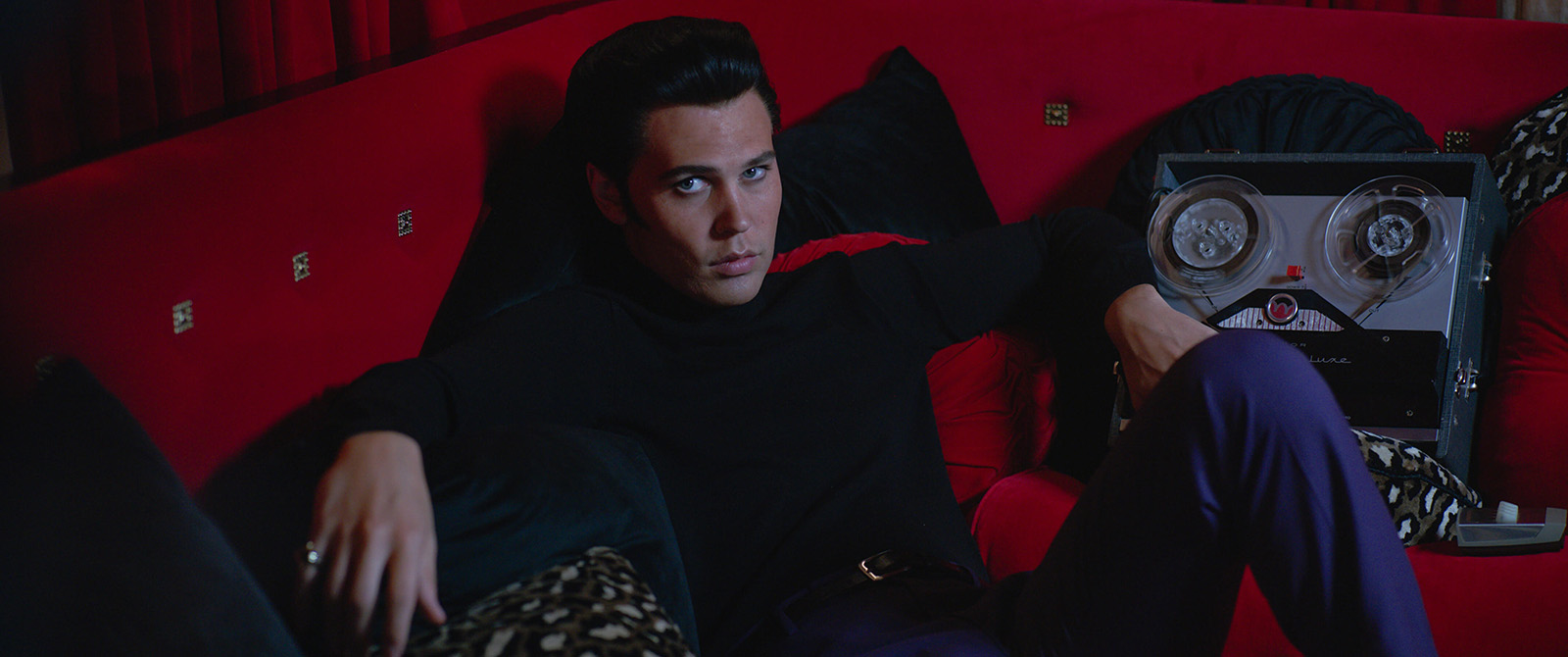
Did some of the montages that are in the show turn into montages because you needed to shorten the film, or were all the montages designed as montages?
VILLA: Baz loves to shoot a lot of his rehearsals, his dress rehearsals, costume tests, and things like that. We all know that a lot of the footage will end up in the film. A lot of that early fifties montage when Elvis goes on the road, that's from various costume tests. Some of them are planned, and some of them just came to be.
You mentioned that those montages were also done in the style of the period, so how much research did you guys do outside of Elvis? It sounds like there was a lot of Elvis research, but was there also watching The Ed Sullivan Show or other shows there were taking place in those various eras?
REDMOND: Baz always has go-to references for the 40's or 50's style montage. He always references Sunrise and some films in the '20s, so we're always researching stuff. We did a deep dive into split screens to see how people approach it in the past and how we might do it differently.
You guys are usually working with Baz. Different directors are different about how much cleaning up they need. When you present something to him, how much do you clean it up? How perfect do you get the audio edits? How much do you worry about the mix?
REDMOND: Anything goes with Baz. He can fill in a lot of blanks in his head. He prefers to see things rough and ready and quickly than to perfect them. We can get any bit of music in there that sets the tone, or the music guys can give us just any old song mashed together. We'll use it. He's really good at reading ideas presented any which way.
That's so interesting. Have you both worked with directors who are different than that?
REDMOND: Yeah.
VILLA: Yeah. Some directors that you think would be really attuned to that style just aren't, which is nobody’s fault. It's just different. You quickly lock into a director's needs and what level of polish they need to get an idea through.
That's interesting because there are so many different ways to approach a scene, and there are also different ways to approach a director. You mentioned earlier that you had an interview with one of your assistant editors. What was it about that person or that interview that made you feel like this person is somebody I can hang out with for the next two years?
VILLA: It was probably foremost on both John's and my mind to gear them up for what they were in for because we knew what the hours would be. Baz likes t
